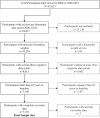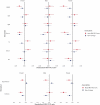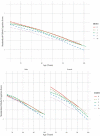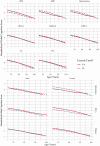Sex Differences in the Association Between Metabolic Dysregulation and Cognitive Aging: The Health and Retirement Study
- PMID: 34606593
- PMCID: PMC9757032
- DOI: 10.1093/gerona/glab285
Sex Differences in the Association Between Metabolic Dysregulation and Cognitive Aging: The Health and Retirement Study
Abstract
Background: Dysregulation of some metabolic factors increases the risk of dementia. It remains unclear if overall metabolic dysregulation, or only certain components, contribute to cognitive aging and if these associations are sex specific.
Methods: Data from the 2006-2016 waves of the Health and Retirement Study (HRS) was used to analyze 7 103 participants aged 65 and older at baseline (58% women). We created a metabolic-dysregulation risk score (MDRS) composed of blood pressure/hypertension status, glycosylated hemoglobin (HbA1c)/diabetes status, total cholesterol (TC), high-density lipoprotein cholesterol (HDL-C), and waist circumference, and assessed cognitive trajectories from repeated measures of the HRS-Telephone Interview for Cognitive Status (HRS-TICS) over 10 years of follow-up. Linear mixed-effects models estimated associations between MDRS or individual metabolic factors (biomarkers) with mean and change in HRS-TICS scores and assessed sex-modification of these associations.
Results: Participants with higher MDRSs had lower mean HRS-TICS scores, but there were no statistically significant differences in rate of decline. Sex stratification showed this association was present for women only. MDRS biomarkers revealed heterogeneity in the strength and direction of associations with HRS-TICS. Lower HRS-TICS levels were associated with hypertension, higher HbA1c/diabetes, and lower HDL-C and TC, whereas faster rate of cognitive decline was associated with hypertension, higher HbA1c/diabetes, and higher TC. Participants with higher HbA1c/diabetes presented worse cognitive trajectories. Sex differences indicated that women with higher HbA1c/diabetes to have lower HRS-TICS levels, whereas hypertensive males presented better cognitive trajectory.
Conclusions: Our results demonstrate that metabolic dysregulation is more strongly associated with cognition in women compared with men, though sex differences vary by individual biomarker.
Keywords: Biomarkers; Brain aging; Diabetes; Epidemiology.
© The Author(s) 2021. Published by Oxford University Press on behalf of The Gerontological Society of America. All rights reserved. For permissions, please e-mail: journals.permissions@oup.com.
Figures




Similar articles
-
HbA1c, diabetes and cognitive decline: the English Longitudinal Study of Ageing.Diabetologia. 2018 Apr;61(4):839-848. doi: 10.1007/s00125-017-4541-7. Epub 2018 Jan 25. Diabetologia. 2018. PMID: 29368156 Free PMC article.
-
Glaucoma and cognitive function trajectories in a population-based study: Findings from the health and retirement study.J Am Geriatr Soc. 2022 Oct;70(10):2827-2837. doi: 10.1111/jgs.17903. Epub 2022 Jun 22. J Am Geriatr Soc. 2022. PMID: 35730426 Free PMC article.
-
Association between visit-to-visit variability of HbA1c and cognitive decline: a pooled analysis of two prospective population-based cohorts.Diabetologia. 2020 Jan;63(1):85-94. doi: 10.1007/s00125-019-04986-8. Epub 2019 Sep 4. Diabetologia. 2020. PMID: 31485707
-
Estimated Pulse Wave Velocity Is Associated With a Higher Risk of Dementia in the Health and Retirement Study.Am J Hypertens. 2024 Oct 14;37(11):909-915. doi: 10.1093/ajh/hpae096. Am J Hypertens. 2024. PMID: 39031044
-
Impact of social integration on metabolic functions: evidence from a nationally representative longitudinal study of US older adults.BMC Public Health. 2013 Dec 20;13:1210. doi: 10.1186/1471-2458-13-1210. BMC Public Health. 2013. PMID: 24359332 Free PMC article.
Cited by
-
Sex Disparity in the Association of Metabolic Syndrome with Cognitive Impairment.J Clin Med. 2024 Apr 27;13(9):2571. doi: 10.3390/jcm13092571. J Clin Med. 2024. PMID: 38731099 Free PMC article.
-
Gender, Age of Migration, and Cognitive Life Expectancies Among Older Latinos: Evidence From the Health and Retirement Study.J Gerontol B Psychol Sci Soc Sci. 2022 Dec 29;77(12):e226-e233. doi: 10.1093/geronb/gbac133. J Gerontol B Psychol Sci Soc Sci. 2022. PMID: 36107795 Free PMC article.
-
Modeling the importance of life exposure factors on memory performance in diverse older adults: A machine learning approach.Alzheimers Dement. 2025 Aug;21(8):e70428. doi: 10.1002/alz.70428. Alzheimers Dement. 2025. PMID: 40832727 Free PMC article.
-
The Association Between Cardiometabolic Risk and Cognitive Function Among Older Americans and Chinese.J Gerontol A Biol Sci Med Sci. 2024 Jul 1;79(7):glae116. doi: 10.1093/gerona/glae116. J Gerontol A Biol Sci Med Sci. 2024. PMID: 38699992 Free PMC article.
-
The association of cholesterol levels with memory and memory change over a 14-year period in a US national cohort.Alzheimers Dement (N Y). 2025 Jan 3;11(1):e70021. doi: 10.1002/trc2.70021. eCollection 2025 Jan-Mar. Alzheimers Dement (N Y). 2025. PMID: 39759951 Free PMC article.
References
Publication types
MeSH terms
Substances
Grants and funding
LinkOut - more resources
Full Text Sources
Medical

